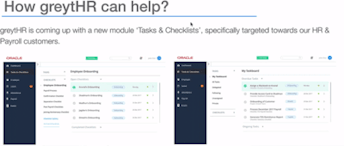greytHR hosted yet another Expert Series Webinar, this time around presented by Sriram from Aventus Partners. The broad theme was Performance Management, and the topic addressed:
Performance Appraisals for SMEs:
Motivating high performers while operationalizing fixed pay increases
Here’s a summary - both for those of you who couldn’t make the live session and attendees who’d like a long hard look at the model proposed by Sriram in order to implement it at their own organizations.
The bell curve: A legacy of the ‘90s
Performance management and the nature and objectives of performance appraisals have changed over the decades. This change has been driven by what the business expects from its employees. In the past, the key business drivers were:
- Ability to dominate the market
- Deliver on economies of scale
- Deliver on a high quality of products
The impact of such a set of objectives on performance management and appraisals was that performance differentiation became a key component of business strategy. That is, organizations came out with systems and strategies to segregate employees into top performers, average performers and underperformers. This system soon came to be trusted across organizations and in fact worked well for around two decades because it:
- Encouraged a pay-for-performance culture
- Facilitated a top-down goal-setting approach
- Led to an improvement in overall organizational performance because the poor performers either voluntarily moved out or were eased out.
But while the system continued to present all these merits, the statistical tool of the bell curve used to support this system quickly took over this system and it morphed into one of forced rankings. Thus, performance differentiation began to get equated with forced rankings. Employees began to get force-fitted into the bell curve and this became default in most organizations.
What has changed over the last few years?
In recent years, business drivers have started shifting. There is, today, a lot of demand for customization of products and services. Irrespective of the size and scale of organizations today, market domination comes from innovation and intellectual property.
This innovation is not created through silos but through interdisciplinary collaboration. So you have:
- teams working across levels and across functions, and
- a very high level of service orientation which is being emphasized.
Today’s organizations are beginning to measure and reward this in an extremely systematic fashion. The generic belief that is becoming embodied is that while differentiation had its merits, organizations today want to have more and more high performers. The belief is that greater the proportion of high performers, greater is the value created for customers. And therefore performance management and performance appraisal systems are being molded to suit these expectations of superior delivery.
Differentiation still works, but the bell curve doesn’t
So, in this new scenario, differentiation still works, but the bell curve doesn’t work for the following reasons:
- It wrongly assumes that an equal number of people lie above and below the mean:
The bell curve basically assumes that you have 50% employees who are good performers or exceptional performers and the other 50% lie on the other side of the spectrum. This results in many dissatisfied employees whose ratings have been normalized, especially when you have to push them to comply with an overall curve.
- Goals today are no longer pushed top to bottom but emerge through collaboration.
However, forced rankings are still in use as:
- It helps organizations, especially large ones, make sense of a lot of data
- Many managers still believe that the bell curve, when used appropriately, continues to add value
- In a number of cases, people simply aren’t aware of alternatives
The way forward: Looking past the bell curve
So, what if there was an alternative? How can we go about rewarding employees on actual performance and not force-fit them into the bell curve/other statistical concepts?
To reiterate, the fundamental behaviors organizations today are trying to drive are collaboration, innovation and risk-taking. To build such a culture, one needs to:
1. Rate absolute performance:
- Create a robust performance management system: Every organization, however big or small, needs a robust performance management system.
- All goals must be quantifiable and measurable: When one speaks of a robust system, very simplistically, what is being alluded to is goals that are quantifiable and measurable. Even for those areas which are subjective, we can have such goals.
- Performance ratings to be assigned only based on the absolute performance of employees: That is, ratings must never be assigned based on relative performance.
- Rate absolute performance of the business/function as well: This is a critical element. Here, businesses too are to be rated on their absolute performance.
- No moderation of ratings at the function, business or organization levels: Such moderation is normally seen in the bell curve system, and must not be taken up.**
2. Rely on holistic assessment
- Certain roles in an organization can not have purely quantifiable goals: For such cases, put in place a process to capture individual performance and service delivery from multiple stakeholders (internal and external).
E.g. Initiate a multi-source / 360-degree feedback process and use the inputs received while having conversations with employees.
3. Let the data speak: Allow the curve to emerge from the data
- Do not force fit performance data
- Instead, allow the curve to emerge from the data
- Measure the performance of teams and departments on the same parameters
- Correlate this data with the group/organization’s performance
4. Ensure that people are rated based on consistent performance
- Periodically review and categorize employees basis the levels of Consistent Actual Performance and inputs from the Holistic Assessment: Performance management should not be a once- / twice-a-year activity, but a continuous process of check-in and course corrections.
- The objective is to enable decision makers to identify and take steps to:
- Retain Consistent Overachievers
- Create growth opportunities for Consistent Achievers
- Provide tools and coaching for Near Achievers and Under Achievers to help them reach their goals
5. Arrive at compensation increases based on a composite set of factors
Use fixed and variable pay increases judiciously
Whereas fix pay should be used on a composite (2 or more) set of factors to reward performance on a consistent, long-term basis, variable pay may be used to reward performance for half-yearly/annual periods.
So the essential distinction is: award variable pay for a defined period vs. fixed pay for a longer terms basis a composite set of factors.
You could have a host of factors based on which fixed pay increases may be awarded and organizations can decide on these factors based on what the behaviors are that you are trying to drive to achieve your business goals.
Potential factors that can be used include:
- Consistency of achieving goals
- Criticality of employee’s skills
- Internal criticality of role
- Estimated cost of replacement
- Employee’s current compensation positioning vis a vis the comparator market
- Employee’s current compensation positioning vis a vis the internal compensation bands
A Case Study: The 5 principles in action
This case study is a simulation created by Aventus Partners and is not reflective of any actual organization.
The case study details how one can go about implementing a new performance management system (PMS) based on the above 5 principles - primarily a system based on actual performance (and not relative performance, as in the case of the bell curve). We strongly recommend that you view/download the case study in case you’re looking to replace the PMS at your organization.
Objectives of the Case Study
- To move beyond a system that is being practiced in such a way that it is negatively affecting employee morale and to a system that is fair and transparent
- To redistribute the same compensation budget among employees to get a better return for the buck.









